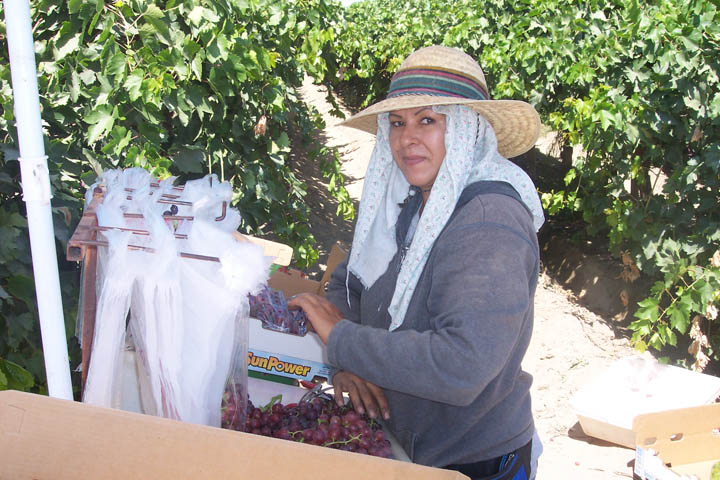
Record high temperatures are creating dangerous conditions for those who must work outdoors.Texas AgriLife specialists are advising those that must do so to exercise caution and be aware of the risks.They say what may start as muscle cramps can easily lead to heat exhaustion and other heat-related problems.

Record high temperatures across the Southwest are raising the warning flag for those who must work outdoors beneath the searing sun. In less time than most realize, health officials warn dehydration can not only zap the body of its energy, it can be deadly.
Josefa Peña, Texas AgriLife Extension health specialist, warns of the dangers of working in extreme heat conditions and advises those that must do so to exercise caution and to be aware of the risks. What may start as muscle cramps can easily lead to heat exhaustion, a feeling of fatigue and illness, including dizziness and nausea, which occurs when the body loses too much salt and water as the result of heavy perspiration.
While is not uncommon for individuals working in the hot summer sun to suffer various stages of heat exhaustion that can be temporarily debilitating, of greater concern is that it can quickly lead to potentially fatal heatstroke if not treated promptly. Farmers and ranchers are particularly at risk once temperatures reach danger levels, especially if they fail to drink enough fluids to rehydrate the body.
According to the Mayo Clinic, heatstroke is the most severe of heat-related problems, after heat cramps and heat exhaustion. It is often caused by extreme heat and physical exertion combined with inadequate fluid intake. What makes heatstroke severe and potentially life-threatening is that the body's normal mechanisms for dealing with heat stress, such as sweating and temperature control, become inadequate.
The main sign of heatstroke is a markedly elevated body temperature often followed with changes in mental status ranging from personality changes to confusion and coma. Skin may be hot and dry, although if heatstroke is caused by exertion, the skin may be moist.
Types of Heat-Related Problems
When working in extreme heat conditions, paying attention to your physical condition can help you avoid heatstroke. The first signs of becoming overheated include symptoms of painful cramping and spasms in the legs, arms and/or abdominal (stomach) muscles. If unchecked, heat exhaustion may be quick to follow. Heat exhaustion symptoms include feeling tired, weak, and dizzy; headache, nausea and possibly vomiting can follow.
Heatstroke symptoms include feeling tired, weak and dizzy and your skin may feel hot and dry, even under armpits, and it may appear red and flushed. Under extreme heatstroke conditions, you may become delirious and unconscious.
Managing Risks of Heat Illness
According to Pena, drink lots of cool water, even more than you think you need, when the weather is hot and humid. High humidity makes heat injuries more likely because perspiration does not evaporate from the skin as quickly and this causes the body to cool down more slowly. Water is best; fruit and vegetable juices will also help.
Drink at least a gallon of liquid a day (about 16 glasses) when the outside temperature is above 90 degrees and you are not in air conditioned surroundings. This will mean drinking one and a half times as much liquid as your thirst signals you to drink. Being overweight adds to heat-related illness, and those carrying a few extra pounds need even more water than others.
Avoid drinking beer and other alcoholic beverages and coffee, tea or other drinks containing caffeine as they can cause you to lose fluid. Health officials say it is also important to maintain normal salt intake. No more than one and a half teaspoons of salt are recommended each day.
It is also a good to wear light-colored clothes that are loosely woven and absorbent. Cotton is best as it absorbs 40 percent of its weight in moisture. Most synthetic (manmade) materials tend to trap body heat and are not absorbent. It is also best to wear a hat to shade your head.
If you are required to work outside during peak heat hours, take frequent breaks and drinks of cool water. Do not exert any more energy than necessary during the heat of the day. On extreme hot days it even wise to get wet, wear wet clothing, or bathe/shower as often as possible without drying yourself to give your body cooling system a boost.
In the absence of air conditioning, use a fan if at all possible. If your truck or equipment is not air conditioned, drive with the windows down to create cross ventilation. It is also important to realize that as we age we become more sensitive to heat and may easily suffer from heat-related illness. This is especially true for the elderly. Also, anyone with diabetes, heart disease, arteriosclerosis, high blood pressure, or Parkinson’s Disease is more sensitive to the effects of heat.
Texas AgriLife Extension recommends the following treatments for health problems associated with extreme heat:
Heat Cramps
Rest in a cool, shaded area and drink cool water slowly. About four ounces of water every 15 minutes is best. Stretch your muscles slowly and massage cramps to get relief.
Heat Exhaustion
In a cool, shaded area, lie down with your feet raised about 10 inches. Loosen all clothing to allow better air circulation and drink water slowly (four ounces every 15 minutes). Place cool, wet clothes on your forehead and body.
Heatstroke
It is important to remove clothing and apply a sponge of cool water across the body. Use a fan if available or fan your body with your clothes if necessary. Heatstroke is a life-threatening condition and medical attention is needed immediately.
Finally, since many farmers and ranchers work solo in the field, having a cell phone handy can save your life. Call someone at the first signs of heat exhaustion.
About the Author(s)
You May Also Like



